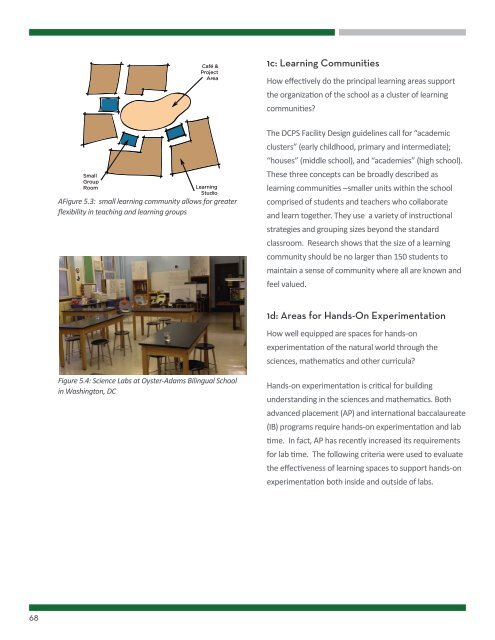DISTRICT COLUMBIA
DISTRICT COLUMBIA
DISTRICT COLUMBIA
Create successful ePaper yourself
Turn your PDF publications into a flip-book with our unique Google optimized e-Paper software.
68<br />
and democratically decide who gets to use which space<br />
when. That said, each teacher will have a professionally<br />
outfitted workspace alongside their colleagues in the<br />
teacher’s office, which is also part of the SLC.<br />
12 The Language of School Design<br />
Café &<br />
Project<br />
Area<br />
its own science room, its own teacher workroom with<br />
the transparency needed for the space to serve as "eyes<br />
on the street", its own toilets, its own science lab and its<br />
own central multi-purpose social space that can be used<br />
for project work, independent study, distance learning,<br />
collaborative work, technology-based work and so on.<br />
Figure 1-9 shows a simpler arrangement than the SLC<br />
described above with Learning Studios clustered around<br />
small group rooms and a café that doubles as a project<br />
area. But even at this simple level, it is possible to create an<br />
effective SLC.<br />
1c: Learning Communities<br />
How effectively do the principal learning areas support<br />
the organization of the school as a cluster of learning<br />
communities?<br />
This particular pattern could be modified to show each<br />
SLC having its own direct connection to the outdoors.<br />
Additionally, each Learning Studio itself could have<br />
an outdoor connection. The floor plan (Figure 1-10)<br />
and photograph of the Djidi Djidi Aboriginal School<br />
in Australia (Figure 1-11) feature another example of<br />
how Learning Studios can be combined with other<br />
common spaces to create self-contained Small Learning<br />
Communities.<br />
Small<br />
Group<br />
Room<br />
Learning We have utilized one more image to represent the SLC<br />
Studio<br />
model. Figure 1-12, the High Tech Middle School in San<br />
AFigure 5.3: small learning community allows for greater<br />
Figure 1-9.<br />
Diego, California illustrates how a common area shared by<br />
flexibility Design in teaching Pattern #1e: and Learning learning Studio-based groups Small an SLC might be used.<br />
Learning Community (SLC).<br />
Figure 5.4: Science Labs at Oyster-Adams Bilingual School<br />
in Washington, DC<br />
The DCPS Facility Design guidelines call for “academic<br />
clusters” (early childhood, primary and intermediate);<br />
“houses” (middle school), and “academies” (high school).<br />
These three concepts can be broadly described as<br />
learning communities –smaller units within the school<br />
comprised of students and teachers who collaborate<br />
and learn together. They use a variety of instructional<br />
Figure 1-11.<br />
strategies and grouping sizes beyond the standard<br />
classroom. Research shows that the size of a learning<br />
community should be no larger than 150 students to<br />
maintain a sense of community where all are known and<br />
feel valued.<br />
1d: Areas for Hands-On Experimentation<br />
How well equipped are spaces for hands-on<br />
experimentation of the natural world through the<br />
sciences, mathematics and other curricula?<br />
Figure 1-10.<br />
Djidi Djidi Aboriginal School d<br />
Architect: Edgar Idle Wade.<br />
Djidi Djidi Aboriginal School, a<br />
Hands-on experimentation is critical for building<br />
understanding in the sciences and mathematics. Both<br />
advanced placement (AP) and international baccalaureate<br />
(IB) programs require hands-on experimentation and lab<br />
time. In fact, AP has recently increased its requirements<br />
for lab time. The following criteria were used to evaluate<br />
the effectiveness of learning spaces to support hands-on<br />
experimentation both inside and outside of labs.


